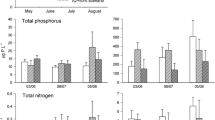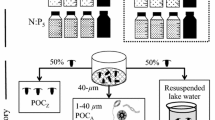Abstract
Plankton in mountain lakes are confronted with generally higher levels of incident ultraviolet radiation (UVR), lower temperatures, and shorter growing seasons than their lower elevation counterparts. The direct inhibitory effects of high UVR and low temperatures on montane phytoplankton are widely recognized. Yet little is known about the indirect effects of these two abiotic factors on phytoplankton, and more specifically whether they alter zooplankton grazing rates which may in turn influence phytoplankton. Here, we report the results of field microcosm experiments that examine the impact of temperature and UVR on phytoplankton growth rates and zooplankton grazing rates (by adult female calanoid copepods). We also examine consequent changes in the absolute and relative abundance of the four dominant phytoplankton species present in the source lake (Asterionella formosa, Dinobryon sp., Discostella stelligera, and Fragilaria crotonensis). All four species exhibited higher growth rates at higher temperatures and three of the four species (all except Dinobryon) exhibited lower growth rates in the presence of UVR versus when shielded from UVR. The in situ grazing rates of zooplankton had significant effects on all species except Asterionella. Lower temperatures significantly reduced grazing rates on Fragilaria and Discostella, but not Dinobryon. While UVR had no effect on zooplankton grazing on any of the four species, there was a significant interaction effect of temperature and UVR on zooplankton grazing on Dinobryon. Discostella and Dinobryon increased in abundance relative to the other species in the presence of UVR. Colder temperatures, the presence of zooplankton, and UVR all had consistently negative effects on rates of increase in overall phytoplankton biomass. These results demonstrate the importance of indirect as well as direct effects of climate forcing by UVR and temperature on phytoplankton community composition in mountain lakes, and suggest that warmer climates and higher UVR levels may favor certain species over others.



Similar content being viewed by others
References
Arts, M. T. & H. Rai, 1997. Effects of enhanced ultraviolet-B radiation on the production of lipid, polysaccharide and protein in three freshwater algal species. Freshwater Biology 38: 597–610.
Arzet, K. 1987. Diatomeen als pH-Indikatoren in subrezenten Sedimenten von Weichwasserseen. Universität Innsbruck.
Ballaré, C. L., M. C. Rousseaux, P. S. Searles, J. G. Zaller, C. V. Giordano, T. M. Robson, M. M. Caldwell, O. E. Sala & A. L. Scopel, 2001. Impacts of solar ultraviolet-B radiation on terrestrial ecosystems of Tierra del Fuego (southern Argentina)—an overview of recent progress. Journal of Photochemistry and Photobiology B-Biology 62: 67–77.
Boeing, W. J., D. M. Leech, C. E. Williamson, S. L. Cooke & L. Torres, 2004. Damaging UV radiation and invertebrate predation: conflicting selective pressures for zooplankton vertical distribution in the water column of low DOC lakes. Oecologia 138: 603–612.
Bothwell, M. L., D. Sherbot, A. C. Roberge & R. J. Daley, 1993. Influence of natural ultraviolet radiation on lotic periphytic diatom community growth, biomass accrual, and species composition: short-term versus long-term effects. Journal of Phycology 29: 24–35.
Bothwell, M. L., D. M. J. Sherbot & C. M. Pollock, 1994. Ecosystem response to solar ultraviolet-B radiation: influence of trophic-level interactions. Science 265: 97–100.
Cooke, S. L., C. E. Williamson & J. E. Saros, 2006. How do temperature, dissolved organic matter and nutrients influence the response of Leptodiaptomus ashlandi to UV radiation in a subalpine lake? Freshwater Biology 51: 1827–1837.
Cooke, S. L., C. E. Williamson, D. M. Leech, W. J. Boeing & L. Torres, 2008. Effects of temperature and ultraviolet radiation on diel vertical migration of freshwater crustacean zooplankton. Canadian Journal of Fisheries and Aquatic Sciences 65: 1144–1152.
de Lange, H. J. & M. Lurling, 2003. Effects of UV-B irradiated algae on zooplankton grazing. Hydrobiologia 491: 133–144.
Doyle, S. A., J. E. Saros & C. E. Williamson, 2005. Interactive effects of temperature and nutrient limitation on the response of alpine phytoplankton growth to ultraviolet radiation. Limnology and Oceanography 50: 1362–1367.
Hessen, D. O., H. J. De Lange & E. Van Donk, 1997. UV-induced changes in phytoplankton cells and its effects on grazers. Freshwater Biology 38: 513–524.
Infante, A. & A. H. Litt, 1985. Differences between two species of Daphnia in the use of 10 species of algae in Lake Washington. Limnology and Oceanography 30: 1053–1059.
Krammer, K., & H. Lange-Bertalot, 1986–1991. Susswasserflora von Mitteleuropa. Bacillariophyceae. Gustav Fischer Verlag, Stuttgart.
Leech, D. M. & C. E. Williamson, 2001. In situ exposure to UV radiation alters the depth distribution of Daphnia. Limnology and Oceanography 46: 416–420.
Leu, E., P. J. Faerovig & D. O. Hessen, 2006. UV effects on stoichiometry and PUFAs of Selenastrum capricornutum and their consequences for the grazer Daphnia magna. Freshwater Biology 51: 2296–2308.
Ochs, C. A. & L. P. Eddy, 1998. Effects of UV-A (320 to 399 nanometers) on grazing pressure of a marine heterotrophic nanoflagellate on strains of the unicellular cyanobacteria Synechococcus spp. Applied and Environmental Microbiology 64: 287–293.
Parker, B. R., R. D. Vinebrooke & D. W. Schindler, 2008. Recent climate extremes alter alpine lake ecosystems. Proceedings of the National Academy of Sciences of the United States of America 105: 12927–12931.
Pilati, A. & W. A. Wurtsbaugh, 2003. Importance of zooplankton for the persistence of a deep chlorophyll layer: a limnocorral experiment. Limnology and Oceanography 48: 249–260.
Psenner, R. & R. Schmidt, 1992. Climate-driven pH control of remote alpine lakes and effects of acid deposition. Nature 356: 781–783.
Rae, R. & W. F. Vincent, 1998. Effects of temperature and ultraviolet radiation on microbial food web structure: potential responses to global change. Freshwater Biology 40: 747–758.
Roos, J. C. & W. F. Vincent, 1998. Temperature dependence of UV radiation effects on Antarctic cyanobacteria. Journal of Phycology 34: 118–125.
Saros, J. E., S. Interlandi, A. P. Wolfe & D. R. Engstrom, 2003. Recent changes in the diatom community structure of lakes in the Beartooth Mountain Range. U.S.A. Arctic Antarctic and Alpine Research 35: 18–23.
Saros, J. E., S. J. Interlandi, S. Doyle, T. J. Michel & C. E. Williamson, 2005a. Are the deep chlorophyll maxima in alpine lakes primarily induced by nutrient availability, not UV avoidance? Arctic Antarctic and Alpine Research 37: 557–563.
Saros, J. E., T. J. Michel, S. Interlandi & A. P. Wolfe, 2005b. Resource requirements of Asterionella formosa and Fragilaria crotonensis in oligotrophic alpine lakes: implications for recent phytoplankton community reorganizations. Canadian Journal of Fisheries and Aquatic Sciences 62: 1681–1689.
Scott, J. D., L. Chalker-Scott, A. E. Foreman & M. D’Angelo, 1999. Daphnia pulex fed UVB-irradiated Chlamydomonas reinhardtii show decreased survival and fecundity. Photochemistry and Photobiology 70: 308–313.
Sickman, J. O., J. M. Melack & D. W. Clow, 2003. Evidence for nutrient enrichment of high-elevation lakes in the Sierra Nevada, California. Limnology and Oceanography 48: 1885–1892.
Sommaruga, R., 2001. The role of solar UV radiation in the ecology of alpine lakes. Journal of Photochemistry and Photobiology B: Biology 62: 35–42.
Van Donk, E., 1997. Defenses in phytoplankton against grazing induced by nutrient limitation, UV-B stress and infochemicals. Aquatic Ecology 31: 53–58.
Van Donk, E. & D. O. Hessen, 1995. Reduced digestibility of UV-B stressed and nutrient-limited algae by Daphnia magna. Hydrobiologia 307: 147–151.
Wang, K. S. & T.-J. Chai, 1994. Reduction in omega-3 fatty acids by UV-B irradiation in microalgae. Journal of Applied Phycology 6: 415–421.
Wehr, J. D., & R. G. Sheath, 2003. Freshwater algae of North America: ecology and classification. Academic Press, San Diego.
Williamson, C. E., B. R. Hargreaves, P. S. Orr & P. A. Lovera, 1999. Does UV play a role in changes in predation and zooplankton community structure in acidified lakes? Limnology and Oceanography 44: 774–783.
Williamson, C. E., P. J. Neale, G. Grad, H. J. de Lange & B. R. Hargreaves, 2001. Beneficial and detrimental effects of UV radiation on aquatic organisms: implications of variation in spectral composition. Ecological Applications 11: 1843–1857.
Williamson, C. E., W. Dodds, T. K. Kratz & M. A. Palmer, 2008. Lakes and streams as sentinels of environmental change in terrestrial and atmospheric processes. Frontiers in Ecology and the Environment 6: 247–254.
Williamson, C. E., J. E. Saros & D. W. Schindler, 2009. Sentinels of change. Science 323: 887–888.
Winder, M. & D. E. Schindler, 2004. Climate change uncouples trophic interactions in an aquatic ecosystem. Ecology 85: 2100–2106.
Wolfe, A. P., J. S. Baron & R. J. Cornett, 2001. Anthropogenic nitrogen deposition induces rapid ecological changes in alpine lakes of the Colorado Front Range (USA). Journal of Paleolimnology 25: 1–7.
Acknowledgments
We thank Ryan Lockwood, Kirsten Kessler, Lindsay Boateng, Shaina Keseley, and Caren Scott for field assistance. This work was supported by NSF Grant DEB-IRCEB-0210972.
Author information
Authors and Affiliations
Corresponding author
Additional information
Guest editors: Hilde Eggermont, Martin Kernan & Koen Martens / Global change impacts on mountain lakes
An erratum to this article can be found at http://dx.doi.org/10.1007/s10750-010-0336-2
Rights and permissions
About this article
Cite this article
Williamson, C.E., Salm, C., Cooke, S.L. et al. How do UV radiation, temperature, and zooplankton influence the dynamics of alpine phytoplankton communities?. Hydrobiologia 648, 73–81 (2010). https://doi.org/10.1007/s10750-010-0147-5
Published:
Issue Date:
DOI: https://doi.org/10.1007/s10750-010-0147-5




